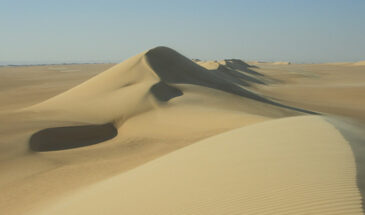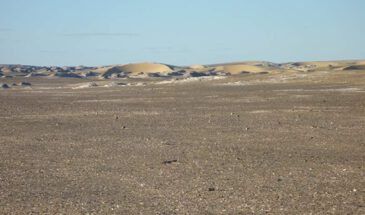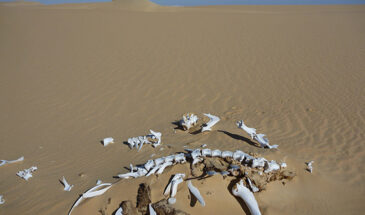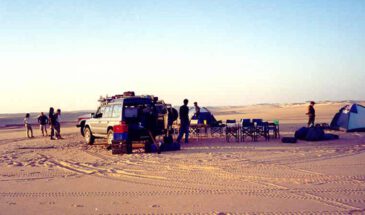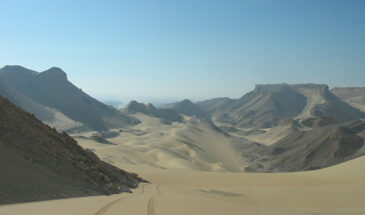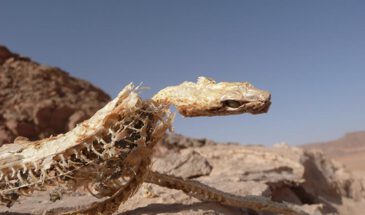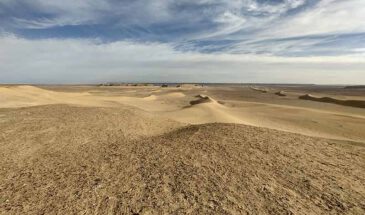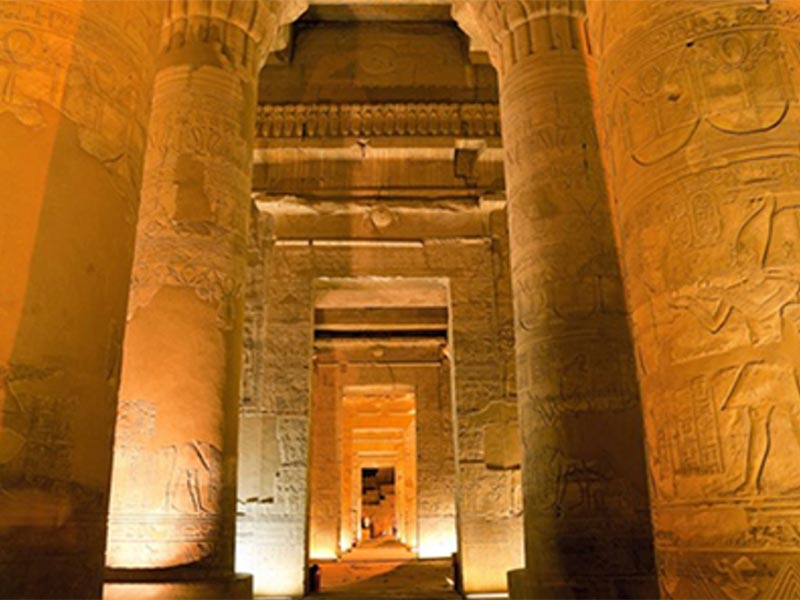- Overview
- Trip Outline
- Trip Includes
- Trip Excludes
- Gallery
- Booking
- FAQ
See life from a different perspective.
Finally!
We invite you to follow us again into the sand. When we are leaving the asphalt, the orientation changes. Let's start with the World Heritage Site of Wadi El Hitan, going further to visit the unique Djara Cave and let's take on the challenge of crossing the sand dunes of Abu Mohareq and conquering the so-called Pass de fou (pass of the crazy).
Nights under the stars, following your own rhythm, immersing yourself in infinity on the trail of time.
Beside psychology reasons there are also physical reasons why to travel to the desert. A benefit of the dry climate is vitamin D. Sunlight helps the body synthesize vitamin D, which contributes to bone and tooth health, strengthens the body's immune system, improves mood and helps fight depression.
Deserts provide room to breathe. Even the plants give each other some space. Such simplicity is augmented by the clarity that low humidity adds to the air. A clarity that brings out the night sky in that jaw-dropping way.
Let's go!
Day 1: Cairo – Wadi Haitan - Kusur al Arab
We start in Cairo around 7 am, heading to the World Heritage Site of Wadi El Hitan.
Wādī al-Ḥītān (Arabic: وادي الحيتان, lit. 'Wadi of the Whales') is a paleontological site in the Faiyum Governorate of Egypt, some 150 kilometres (93 mi) south-west of Cairo. It was designated a UNESCO World Heritage Site in July 2005 for its hundreds of fossils of some of the earliest forms of whale, the archaeoceti (a now extinct sub-order of whales). The site reveals evidence for the explanation of one of the greatest mysteries of the evolution of whales: the emergence of the whale as an ocean-going mammal from a previous life as a land-based animal.
No other place in the world yields the number, concentration and quality of such fossils, nor their accessibility and setting in an attractive and protected landscape. The valley was therefore inscribed on the UNESCO World Heritage List in 2005.
Take a look also to the Museum before heading forward to the sand dunes of Kusur el Arab. Enjoy some dune driving before we set up our camp.
Enjoy your first night under the stars.
Overnight Camping (L/D)
Day 2: Kusur al Arab - Abu Mahareq
Watch the sunrise from one of the dunes, have a cup of tea or coffee and get ready for another day of dune riding. With a practical eye, the drivers look for the best route over the dune crests - if they don't succeed straight away, everyone is asked to shovel the car free again.
You probably haven't enjoyed lunch this much in a long time:))
Find a new home for the night and have a good rest.
Overnight camping (B/L/D).
Day 3: Abu Mahareq - Djara Cave
After breakfast we are following the path to explore one special high light of the trip: Djara Cave.
Hidden within the Western Desert of Egypt, Djara Cave is a subterranean marvel that has been carved out over thousands of years. This limestone cave, also known as the Magic Spring Cave, is characterized by its stunning stalagmites and stalactites, intricate rock formations, and underground water channels.
Take your time to wander around or just sit inside and feel the special atmosphere.
Overnight Camping (B/L/D).
Day 4: Djara Cave - Abu Mahareq
Meanwhile you got the rhythm of desert nomad life. An early morning walk through the dunes, cleaning up the campsite, and off to a new day.
Outdoor lunch, towards the afternoon looking for a nice campsite to spend the night. A delicious barbecue or a campfire in the evening, good conversations - life can be so easy.
Overnight Camping (B/L/D).
Day 5: Abu Mahareq - Pass du Fou
Every desert trip has its special challenges. Today you will experience one. Cross the dunes till a special descent - the so called Pass du fou - a descent for crazy people.
But don't worry - our drivers know what to do - and if you don't feel like, you also may walk dawn from the plateau.
Overnight camping (B/L/D).
Day 6: Pass du Fou - Labaka
After breakfast we start moving slowly in direction to the oasis of Kharga.
Set amid a desertscape of duney desolation, Qasr Al Labakha is a micro-oasis some 40km north of Al Kharga. Scattered among sandy swells and rocky shelves are the remains of a towering four-storey Roman fortress, two temples and a vast necropolis where more than 500 mummies have been unearthed (you can still see human remains in the tombs).
We let the dead of past centuries rest and find our own place to enjoy another night in the desert.
Overnight Camping (B/L/D).
Day 7: Labaka - Um Dabadib
Our new highlight for today:
The Roman/Byzantine village of Ain Umm Dabadib is located to the north of Qasr in the Kharga Oasis. The most distinctive attribute of the site is the square towers of the mudbrick fortress, as most others in the area are rounded.
Other ruins at Ain Umm Dabadib include a temple, Coptic church, tombs, and four underground aqueducts They run for over 3 miles with vents for cleaning and repairs every few so often that are covered by large, flat stones. The site is typical of oases fortresses, which is near a spring.
Overnight Camping (B/L/D).
Day 8: Um Dababdib - Kharga - Bagawat - Hibis - Cairo
Today our desert tour is coming to an end. Even though the soul will take longer to return, our bodies have to adapt more quickly.
Let's take a look at a few special features before the path takes us back to the city.
Alternatively, there is also the option of continuing to Luxor and booking a follow-up program there.
The El Bagawat cemetery is reported to be pre-historic and is one of the oldest Christian cemeteries in Egypt. Before Christianity was introduced into Egypt, it was a burial ground used by the non-Christians and later by the Christians. The chapels here are said to belong to both the eras. Coptic frescoes of the 3rd to the 7th century are found on the walls. There are 263 funerary chapels, of which the Chapel of the Exodus (first half of the 4th century) and Chapel of Peace (5th or 6th century) have the best-preserved frescoes, although fresco fragments can also be seen in Chapels 25, 172, 173, 175, and 210.
The Temple of Hibis is the largest and best preserved ancient Egyptian temple in the Kharga Oasis, as well as the only structure in Egypt dating to the Saite-Persian period (664–404 BCE) which has come down to modern times in relatively good condition. Located about 2 km north of Kharga, it was devoted to a syncretism of two local forms of the deity Amun: "Amun of Hibis" and "Amun-Ra of Karnak who dwells in Hibis".
It is alternatively believed to be dedicated to Amun and Osiris, its sanctuary contains depictions of hundreds of Egyptian deities.
Option Luxor instead of Cairo
- Private Tour
- 7 Nights camping
- Meals: 7 B/ 7 L/ 7 D
- All transport in 4x4 cars
- Program like mentioned above.
- International flights
- Visa fees
- Travel insurance and all kind of insurances.
- Meals and drinks in restaurants
- Tips for guide, drivers...
- Entry fees
- Anything that is not mentioned in the program.
No Details Found


